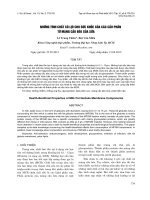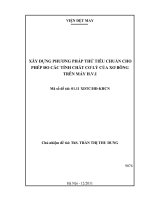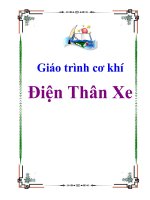TÍNH BỀN CƠ KHÍ CHO THÂN VÀ ĐÁY,NẮP THIẾT BỊ THEO AD2000 CODE (DIN)
Bạn đang xem bản rút gọn của tài liệu. Xem và tải ngay bản đầy đủ của tài liệu tại đây (2.75 MB, 64 trang )
TRƯỜNG ĐẠI HỌC BÁCH KHOA TP. HỒ CHÍ MINH
KHOA KỸ THUẬT HÓA HỌC
BỘ MÔN QUÁ TRÌNH & THIẾT BỊ
MÔN THIẾT KẾ CƠ KHÍ THIẾT BỊ HÓA
TIỂU LUẬN
ĐỀ TÀI: TÍNH BỀN CƠ KHÍ CHO THÂN VÀ ĐÁY,NẮP THIẾT BỊ
THEO TIÊU CHUẨN CHLB ĐỨC
AD2000 CODE
Nhóm 11:
Tên
MSSV
Tên
MSSV
Trương Thanh Tiến
61203843
Huỳnh Quang Tiên
61203793
Ngô Đức Phước
61202889
Phan Đình Khoa
61201714
Vũ Văn Dũng
606T3071
Vũ Trung Tín
61203889
GVHD: Nguyễn Hữu Hiếu
Content
I. Introduce
II. Calculation Method
1. Parameter calculation
2. Cylindrical Shell
2.1 internal pressure
2.2 external pressure
3. End and head
II. Example
I.Introduction
The AD 2000 Code of
practice for pressure vessels
is drawn up by the German
Pressure Vessel Association.
Series
•
•
•
•
•
•
•
•
Equipment, installation and marketing (A)
Design (B)
Fundamentals (G)
Manufacturing and testing (HP)
Non-metallic materials (N)
Special cases (S)
Materials (W)
Additional notes (Z)
Standard
DIN
DIN ISO
DIN EN
DIN EN ISO
Ex:
- DIN EN 10028 – EN 10028 : Flat products made of
steel for pressure purpose
- (DIN 2391-1); DIN EN 10305-1; EN 10305-1:
Seamless precision steel tubes
II. Calculation Method
1. Parameter calculation (AD2000-B0)
Calculate the length of the shell
Symbols and units
Design pressure
Design temperature
Design strength value
Safety factor
The permissible design stress
level in joints
Allowances
Minimum wall thickness
Symbols and units
a lever arm mm
b width mm
c1 allowance for minus thickness tolerance mm
c2 wear allowance mm
d diameter of an opening, flange, screw mm
da outside diameter of a tube, nozzle, flange mm
di inside diameter of a tube, nozzle, flange mm
dt pitch diameter mm
dD average gasket diameter mm
e wide side of rectangular or elliptical plate mm
f narrow side of rectangular or elliptical plate mm
g weld thickness mm
h height mm
k0 setting characteristic of gasket mm
k1 service characteristic of gasket mm
l length mm
n number
p design pressure bar
Ps maximum allowable pressure bar
Pt test pressure bar
r generally radius, e.g. transition radius mm
s required wall thickness includin allowances mm
se actual wall thickness mm
v factor indicative of the use of the allowable
design stress in joints or factor allowing for weakening
x decay-length zone
A area mm2
mm
Calculate the length of the shell
-L=H
(shells have fit flange and connected with two flat ends)
- L = H + h/3 (shells connected with two eliptical or spherical ends)
L=l
(b < 0,1L)
L = l-b (b ≥ 0,1L)
(shells have stiffener ring)
C, β design factors
D shell diameter mm
Da outside diameter e.g. of a cylindrical
shell mm
Di inside diameter e.g. of a cylindrical shell
mm
E modulus of elasticity at design
temperature N/mm2
F force N
I planar moment of inertia mm4
K design strength value at design
temperature N/mm2
Kd dimensional stability of sealant at room
temperature N/mm2
K20 design strength value at 20 °C N/mm2
M moment N mm
R radius of curvature mm
S safety factor at design pressure
S´ safety factor at test pressure
SD leak safety factor
SK safety factor against elastic cupping at
design pressure
S'K safety factor against elastic cupping at
test pressure
SL safety factor on the permissible number
W section modulus mm3
Z auxiliary value
v Poisson’s ratio
s stress N/mm2
u, T temperature °C
of load cycles
Design pressure
• P>
PS
ρgh < 5%p => P=Pm
ρgh ≥ 5%p => P=Pm+ ρgh
• If a pressure-bearing wall is subject to pressure on both sides at the
same time, the design shall generally not be based on the pressure
difference
• If a pressure-bearing wall is subject to pressure and vacuum at the
same time, the design pressure is equal to the pressure difference.
Design temperature
- Tmax < 20 °C => T = 20 °C
Type of heating
Design temperature
- Tw < 10oc => see AD 2000Merkblatt W 10 by gases, steam
the maximum temperature of
the heating medium
- For unheated walls: T = Tmmax
in the case of protected
walls, the maximum working
temperature plus 20 K
or liquids
-
For heated walls:
- In the case of brick linings,
it shall be determined by calculation
or measurement
by fire, exhaust
gas or electrical
equipment
in the case of directly heated
walls, the maximum working
temperature plus 50 K
Design strength value
• design temperature : W series of the AD2000
• time-dependent design : AD2000-S 6
Safety factor
• The safety factors shall be taken from Tables 2 and 3 unless differing or
additional data are given in the individual AD 2000-Merkblätter
Allowances
• For austenitic steels and non-ferrous metals,minus
tolerances are not taken into account only when there
is static loading due to internal pressure
• For ferritic steels => c1 = 0
• For austenitic steels and non-ferrous metals => c2 = 0
• For ferritic steels => c2 = 1 mm
The permissible design stress level
in joints
- v=1
- For brazed joints
- Lapped soldered circumferential joints between copper
parts are acceptable provided the lapping is at least 10se up
to a wall thickness of 6 mm and up to Da, p ≤ 2500 mm bar.
- For soldered joints between copper plates with a continuous
strap of width ≥ 12 Se on both sides of the joint, Se ≤ 4 mm
and an allowable Pw ≤ 2 bar
v= 0,8
Minimum wall thickness
• The minimum wall thicknesses specified in the B series
of AD 2000-Merkblatter are nominal wall thicknesses
2.1. Cylindrical shells subjected to
external overpressure
(AD2000-B6)
Scope
- Da/Di ≤ 1,2
- In the case of tubes with Da ≤ 200 mm => Da/Di ≤ 1,7
Calculation steps
Determine minimum
thickness S’ ?
Choose actual
thickness Se ?
Check permissible
stress ?
Choose material ?
Calculate stiffener
ring ?
Step 1: choose material
• Design temperature T
• Design pressure P
• External diameter Da
• Design strength value K
• Wall thickness tolerances C1 (mm)
• Wear allowance C2 (mm)
• Weld joints safety factor v
• Safety factor
- The safety factors for plastic deformation are given in Table 1
- The safety factor for elastic buckling, irrespective of the
material,
SK = 3,0 and u ≤ 1,5 %
If u > 1,5 % =>
SK = 2,25 + 0,5 u.
Pt > 1,3P => SK’ ≥ 2,2 SK/3
u: out-of-roundness (%)
SK: safety factor against elastic cupping at design pressure
S'K: safety factor against elastic cupping at test pressure
Step 2: Calculate minimum thickness S’ ?
• Ceamless, welded or brazed cylindrical shells
=> S’ = 3 mm.
• Cylindrical shells made of aluminium and its alloys
=> S’ = 5 mm.
• Heat-exchanger tubes, S’ < (3 or 5) mm
Step 3: Calculate actual thickness Se
Choose Se ≥ S’
Ex: Se = 5 mm
Design calculations for elastic buckling
3
2
Se − c1 − c2
S
−
c
−
c
E
20
80
2
n
−
1
−
ν
2
e
1
2
.
P1 =
.
+
. n − 1 +
(1)
2
2
2
2
Sk
Da
12(1 −ν )
Da
n
n
2
1
+
÷
(n − 1) 1 + Z ÷
Z
n: the number of buckling ridges
Z: auxiliary value
Integral
≥2
=>
≥Z
Da 3
n =1, 63. 4 2
l ( S e − c1 − c2 )
∏
.Da
Z =0, 5.
l
3
For tubes =>
E
20 Se − c1 − c2
P1 =
.
.
÷ (3)
2
S K 1 −ν
Da
Design calculations for plastic deformed
• For
< 0,5
1
20 K S e −c1 −c2
P2 =
.
.
D
S
Da
1, 5u 1 −0, 2 a ÷Da
l
1
+
100( S e −c1 −c2 )
• For > 0,5
the stiffened lengths
are short
÷
÷
÷
÷(4)
÷
÷
÷









